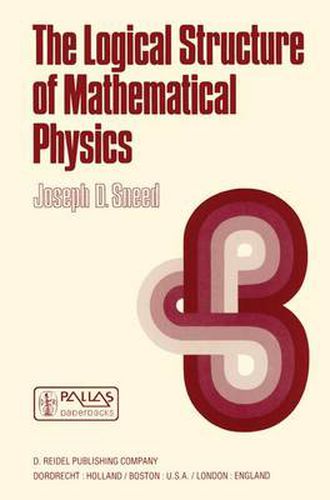Readings Newsletter
Become a Readings Member to make your shopping experience even easier.
Sign in or sign up for free!
You’re not far away from qualifying for FREE standard shipping within Australia
You’ve qualified for FREE standard shipping within Australia
The cart is loading…






This title is printed to order. This book may have been self-published. If so, we cannot guarantee the quality of the content. In the main most books will have gone through the editing process however some may not. We therefore suggest that you be aware of this before ordering this book. If in doubt check either the author or publisher’s details as we are unable to accept any returns unless they are faulty. Please contact us if you have any questions.
This book is about scientific theories of a particular kind - theories of mathematical physics. Examples of such theories are classical and relativis tic particle mechanics, classical electrodynamics, classical thermodynamics, statistical mechanics, hydrodynamics, and quantum mechanics. Roughly, these are theories in which a certain mathematical structure is employed to make statements about some fragment of the world. Most of the book is simply an elaboration of this rough characterization of theories of mathematical physics. It is argued that each theory of mathematical physics has associated with it a certain characteristic mathematical struc ture. This structure may be used in a variety of ways to make empirical claims about putative applications of the theory. Typically - though not necessarily - the way this structure is used in making such claims requires that certain elements in the structure play essentially different roles. Some playa theoretical role; others playa non-theoretical role. For example, in classical particle mechanics, mass and force playa theoretical role while position plays a non-theoretical role. Some attention is given to showing how this distinction can be drawn and describing precisely the way in which the theoretical and non-theoretical elements function in the claims of the theory. An attempt is made to say, rather precisely, what a theory of mathematical physics is and how you tell one such theory from anothe- what the identity conditions for these theories are.
$9.00 standard shipping within Australia
FREE standard shipping within Australia for orders over $100.00
Express & International shipping calculated at checkout
Stock availability can be subject to change without notice. We recommend calling the shop or contacting our online team to check availability of low stock items. Please see our Shopping Online page for more details.
This title is printed to order. This book may have been self-published. If so, we cannot guarantee the quality of the content. In the main most books will have gone through the editing process however some may not. We therefore suggest that you be aware of this before ordering this book. If in doubt check either the author or publisher’s details as we are unable to accept any returns unless they are faulty. Please contact us if you have any questions.
This book is about scientific theories of a particular kind - theories of mathematical physics. Examples of such theories are classical and relativis tic particle mechanics, classical electrodynamics, classical thermodynamics, statistical mechanics, hydrodynamics, and quantum mechanics. Roughly, these are theories in which a certain mathematical structure is employed to make statements about some fragment of the world. Most of the book is simply an elaboration of this rough characterization of theories of mathematical physics. It is argued that each theory of mathematical physics has associated with it a certain characteristic mathematical struc ture. This structure may be used in a variety of ways to make empirical claims about putative applications of the theory. Typically - though not necessarily - the way this structure is used in making such claims requires that certain elements in the structure play essentially different roles. Some playa theoretical role; others playa non-theoretical role. For example, in classical particle mechanics, mass and force playa theoretical role while position plays a non-theoretical role. Some attention is given to showing how this distinction can be drawn and describing precisely the way in which the theoretical and non-theoretical elements function in the claims of the theory. An attempt is made to say, rather precisely, what a theory of mathematical physics is and how you tell one such theory from anothe- what the identity conditions for these theories are.